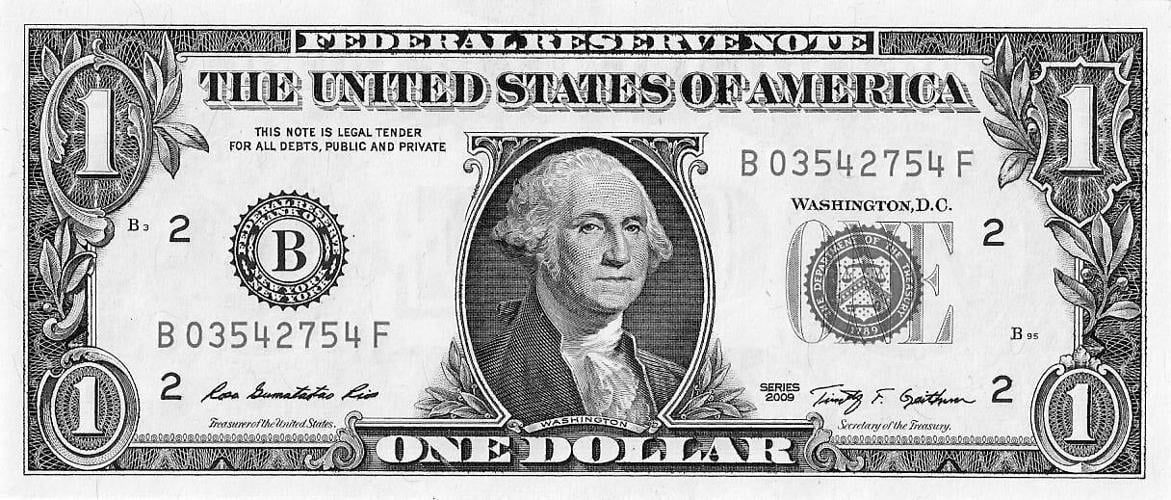You probably see a dollar bill nearly every day, but do you know that the bill is a tribute to George Washington? Washington was born in 1732 in Virginia, served as commander of the Continental Army during the American Revolution, and was the first president of the United States of America—serving two terms until 1797, when he retired to his home at Mount Vernon with his wife Martha Dandridge Custis.
Across the top of the bill, it says “Federal Reserve Note.” There are 12 Federal Reserve banks in districts across the U.S. that are responsible for managing and printing our money. The Reserve Bank of Minneapolis serves Minnesota, Montana, North Dakota, South Dakota, the Upper Peninsula of Michigan, and some northern Wisconsin counties. (Montana is fortunate to have one of the 24 nationwide branch offices in Helena on Neill Avenue.)
To the right of George’s face is the green 1789 Department of Treasury seal. The balancing scales on the seal are a universal symbol of equal justice under the law. Under the scales are 13 stars on a chevron, one for each of the original colonies. The key on the bottom signifies official treasury authority.
There are many important numbers on the face of the bill, mainly for record keeping and to prevent fraud. On the front, a one- or two-digit number appears four times. This number tells us which Federal Reserve bank issued the bill. A “2” on the bill tells us it was entered into circulation by the New York Fed; a “9” would indicate Minneapolis.
By the top-left and bottom-right of the big “1”s in the fancy circles, you’ll see a letter (A to H) and tiny number (1 to 4). The combination refers to the position the note laid on the plate when it was printed. For example, A1 is the top left position on the printing plate, and H4 is the bottom right position.
The back of the bill has lots of really interesting historical information. Right in the center you will see “IN GOD WE TRUST.” On either side are two circles that together comprise the Great Seal of the United States, our principal national symbol. The First Continental Congress requested that Benjamin Franklin, John Adams and Thomas Jefferson design a seal for the new land. It took them four years to accomplish this task and another two years to get it approved.
In the left-hand circle, you will see a pyramid, which represents strength and duration. Notice the front is lighted, and the western side is dark. This country was just beginning. We had not begun to explore the West or decide what our entire nation would become. Inside the capstone there is the all-seeing eye. The designers wanted the seal to have a symbol of divine providence, and the eye shaped like the top of the pyramid is an ancient symbol of divinity. Franklin liked this idea because he believed that one person couldn’t do many things alone, but a group of people, with the help of god, could do almost anything.
Across the bottom row of bricks in the pyramid are the letters “MDCCLXXVI.” These letters aren’t random gibberish—they’re the Roman numerals for 1776, the year America declared its independence from the British.
If you look at the right-hand circle, depicting the obverse side of The Great Seal, there is an eagle. The bald eagle was selected as a symbol of our country because an eagle is strong and smart enough to soar above trouble. In front of the eagle is a shield, which is unsupported to show Americans would now stand on our own—we were no longer a colony of England. The horizontal top bar of the shield symbolizes the federal government. It holds together, yet is supported, by the vertical bars that represent the 13 original states. The stars over the eagle represent the 13 colonies. Surrounding the stars, according to the official description, is glory “breaking through a cloud” above the eagle.
The eagle holds an olive branch representing peace in its right talon. In its left talon, the eagle holds arrows representing readiness to fight if necessary. This country wants peace, but we will never be afraid to fight to preserve peace.
Latin phrases on the back of the dollar bill say “annuit coeptis” above the pyramid, which means, “God has favored our undertaking,” and “novus ordo seclorum” under the pyramid, which means, “a new order of the ages.” On the banner that the eagle holds in its beak is another important Latin phrase, “e pluribus unum.” Appearing on almost all U.S. coins and many historic documents, "e pluribus unum" means, “out of many, one.” Out of many people from many lands—from the Native Americans who were here, to the early settlers, through the newcomers who became proud naturalized citizens of the USA—we would become one strong nation under one U.S. flag, one Constitution and one coinage system.
The number 13—the original number of American states—appears on the $1 bill many times. There are 13 steps in the pyramid; in the right-hand circle there are 13 arrows and 13 olive branch leaves; there are 13 olive fruits; 13 stars above the eagle representing the 13 colonies; and 13 bars on the shield.
Where did we get the idea that 13 is an unlucky number?
Hamman, a Clancy resident, is former deputy director of the Montana Governor’s Office of Budget and Program Planning.



(0) comments
Welcome to the discussion.
Log In
Keep it Clean. Please avoid obscene, vulgar, lewd, racist or sexually-oriented language.
PLEASE TURN OFF YOUR CAPS LOCK.
Don't Threaten. Threats of harming another person will not be tolerated.
Be Truthful. Don't knowingly lie about anyone or anything.
Be Nice. No racism, sexism or any sort of -ism that is degrading to another person.
Be Proactive. Use the 'Report' link on each comment to let us know of abusive posts.
Share with Us. We'd love to hear eyewitness accounts, the history behind an article.